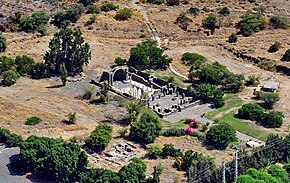Kursi, Golan Heights

Aerial view of the site
|
|
| Region | Golan Heights |
|---|---|
| Coordinates | 32°49′33.91″N 35°39′1.36″E / 32.8260861°N 35.6503778°ECoordinates: 32°49′33.91″N 35°39′1.36″E / 32.8260861°N 35.6503778°E |
| Type | Settlement |
Kursi (Byzantine Greek Κυρσοί) is an archaeological site containing the ruins of a Byzantine monastery and identified by tradition as the site of Jesus' "Miracle of the Swine". The site is now an Israeli national park located in the Israel-occupied side of the Golan Heights. Kursi takes its name from the Talmudic site. A marble slab with Aramaic text discovered in December 2015 seems to indicate that the settlement had, as of ca. 500 CE, a Jewish or Judeo-Christian population.
The site is located near the eastern shore of the Sea of Galilee on the bank of a river bed, Nahal Samakh, descending from the Golan Heights.
Kursi has been identified by tradition as the site of the "Miracle of the Swine", where Jesus healed one or two men possessed by demons by driving these into a herd of pigs (Mark 5:1-20, Matthew 8:28–34, Luke 8:26-39). The details differ somewhat in the three gospels dealing with the episode, and again some more in various ancient manuscripts of those same gospels. The events take place in the land of either the Gerasenes, Gadarenes or Gergesenes (Mark 5:1, Matthew 8:28, Luke 8:26). Exorcised was either one man as per Mark and Luke, or two as per Matthew.
The monastery and its church were built in the 5th century, remaining in use throughout the Byzantine period (in Israeli-Judaic terms: the Mishnaic and Talmudic periods). This being a major pilgrimage site, a number of buildings were built for the accommodation of pilgrims as well as the local monastic community, all surrounded by walls and other fortifications. In 614 the Sassanian (Persian) armies invaded Palestine laying waste to most of its churches and monasteries, including the one at Kursi. The church was later rebuilt, but part of the destroyed settlement was left in its ruined state. The church continued functioning under Muslim rule after the conquest of Palestine in 638-641 until being totally devastated by the 749 earthquake. Arab squatters used the ruins as dwellings and for storage in the 9th century, marking the end of Kursi's use as a Christian pilgrimage site.
...
Wikipedia

